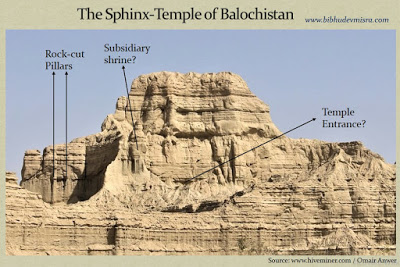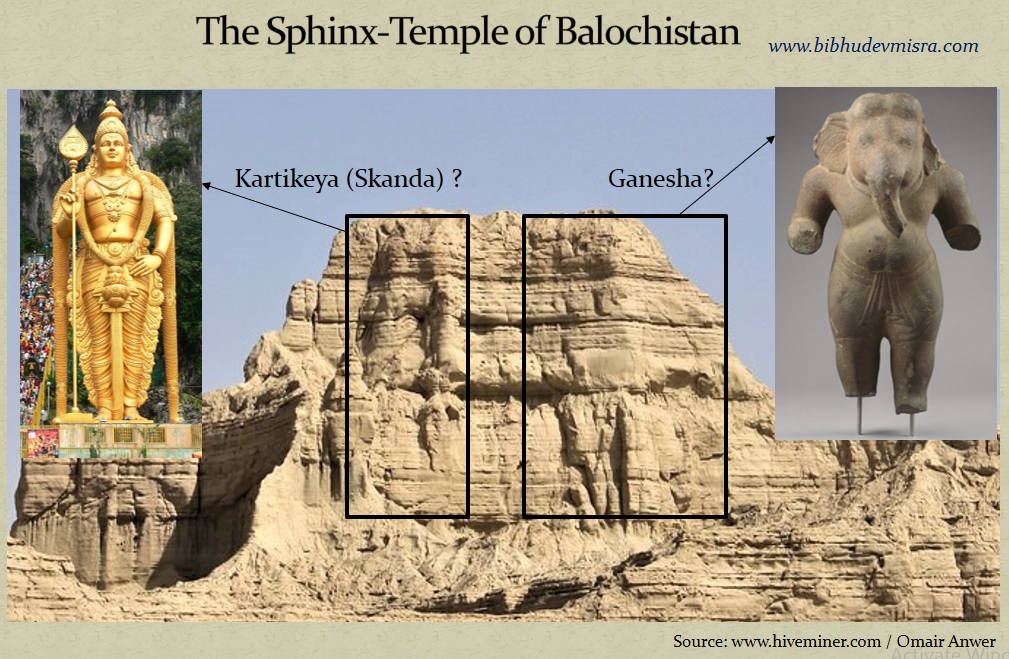Balochistan Sphinx in Hingol National Park
a huge walled temple/castle/city.
From a distance, it looks like a Hindu Temple (like those of South India) with the Mandapa (entrance hall) and the Vimana (temple spire). The top part of the Vimana appears to be missing. The sphinx is reclining in front of the temple, acting as a guardian of the deity embodied in the shrine
On closer inspection, it seems that the Sphinx-Temple may be the Gopuram i.e. entrance tower of a temple. Like the Sphinx-Temple, gopurams are generally flat-topped. Gopurams have a row of ornamental kalasams (stone or metal pots) arranged on the top. If we look carefully at the flat-topped Sphinx-Temple we can see a number of “spikes” on top, which could be a row of kalasams, covered with sediments or termite mounds.
This implies there might be four gopurams in the cardinal directions leading to a central courtyard, where the main shrine of the temple complex was built. The central shrine cannot be seen in this image. The Sphinx is facing the temple complex, possibly towards the gopuram facing east.
The Sphinx-Temple shows clear evidence of pillars carved on the boundary wall. The temple entrance is visible behind a large pile-up of sediments or termite mounds. An elevated, sculpted, structure to the left of the entrance could be a subsidiary shrine. Overall, there is little doubt that this a massive, man-made, rock-cut, temple of immense age.
Throughout the ancient world, the sphinx acted as a protector of sacred places. Perhaps not coincidentally, the Sphinx of Balochistan also appears to be guarding the temple-like structure adjacent to it. This suggests that the site was laid out in accordance with the principles of sacred architecture.
It’s located at the Makran Coastal Highway. with a remarkable rugged landscape (including mountains, cliffs and valleys). the entire landform is made of sedimentary rocks. a large part is covered with drift sand making it look like a coastal semi desert.
The Balochistan Sphinx is routinely passed off by journalists as a natural formation, although no archaeological survey appears to have been conducted on the site. If we explore the features of the structure, as well as its surrounding complex, it becomes difficult to accept the oft-repeated premise that it has been shaped by natural forces. Rather, the site looks like a gigantic, rock-cut, architectural complex.
The Makran coast of Balochistan is a seismically active zone, which frequently produces enormous tsunamis that obliterate entire villages. It has been reported that the earthquake of November 28 1945, with its epicentre off the coast of Makran, caused a tsunami with waves reaching as high as 13m in some places.
Additionally, a number of mud volcanoes are strewn along the Makran coastline, some of which are located in the Hingol National Park, near the Hingol river delta.9 Intense earthquake activity triggers the volcanoes to erupt, spewing staggering amounts of mud, and drowning the surrounding landscape.
Accompanying the sphinx-like structure is the princess of hope.
Baluchistan, the coast Gulf of Oman, and Persian Gulf. If Sumerian had trading with Indus, Indus had trading with Sumer.






